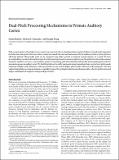| dc.contributor.author | Bendor, Daniel | |
| dc.contributor.author | Osmanski, Michael S. | |
| dc.contributor.author | Wang, Xiaoqin | |
| dc.date.accessioned | 2013-05-07T15:41:08Z | |
| dc.date.available | 2013-05-07T15:41:08Z | |
| dc.date.issued | 2012-11 | |
| dc.date.submitted | 2012-08 | |
| dc.identifier.issn | 0270-6474 | |
| dc.identifier.issn | 1529-2401 | |
| dc.identifier.uri | http://hdl.handle.net/1721.1/78836 | |
| dc.description.abstract | Pitch, our perception of how high or low a sound is on a musical scale, is a fundamental perceptual attribute of sounds and is important for both music and speech. After more than a century of research, the exact mechanisms used by the auditory system to extract pitch are still being debated. Theoretically, pitch can be computed using either spectral or temporal acoustic features of a sound. We have investigated how cues derived from the temporal envelope and spectrum of an acoustic signal are used for pitch extraction in the common marmoset (Callithrix jacchus), a vocal primate species, by measuring pitch discrimination behaviorally and examining pitch-selective neuronal responses in auditory cortex. We find that pitch is extracted by marmosets using temporal envelope cues for lower pitch sounds composed of higher-order harmonics, whereas spectral cues are used for higher pitch sounds with lower-order harmonics. Our data support dual-pitch processing mechanisms, originally proposed by psychophysicists based on human studies, whereby pitch is extracted using a combination of temporal envelope and spectral cues. | en_US |
| dc.description.sponsorship | National Institutes of Health (U.S.) (Grant F31 DC 006528) | en_US |
| dc.description.sponsorship | National Institutes of Health (U.S.) (Grant K99-DC012321-01) | en_US |
| dc.description.sponsorship | Merck Company Foundation (Award) | en_US |
| dc.description.sponsorship | Helen Hay Whitney Postdoctoral Fellowship | en_US |
| dc.description.sponsorship | Charles A. King Trust Postdoctoral Fellowship | en_US |
| dc.language.iso | en_US | |
| dc.publisher | Society for Neuroscience | en_US |
| dc.relation.isversionof | http://dx.doi.org/10.1523/jneurosci.2563-12.2012 | en_US |
| dc.rights | Article is made available in accordance with the publisher's policy and may be subject to US copyright law. Please refer to the publisher's site for terms of use. | en_US |
| dc.source | SFN | en_US |
| dc.title | Dual-Pitch Processing Mechanisms in Primate Auditory Cortex | en_US |
| dc.type | Article | en_US |
| dc.identifier.citation | Bendor, D., M. S. Osmanski, and X. Wang. “Dual-Pitch Processing Mechanisms in Primate Auditory Cortex.” Journal of Neuroscience 32.46 (2012): 16149–16161. | en_US |
| dc.contributor.department | Picower Institute for Learning and Memory | en_US |
| dc.contributor.mitauthor | Bendor, Daniel | |
| dc.relation.journal | Journal of Neuroscience | en_US |
| dc.eprint.version | Final published version | en_US |
| dc.type.uri | http://purl.org/eprint/type/JournalArticle | en_US |
| eprint.status | http://purl.org/eprint/status/PeerReviewed | en_US |
| dspace.orderedauthors | Bendor, D.; Osmanski, M. S.; Wang, X. | en |
| mit.license | PUBLISHER_POLICY | en_US |
| mit.metadata.status | Complete | |
